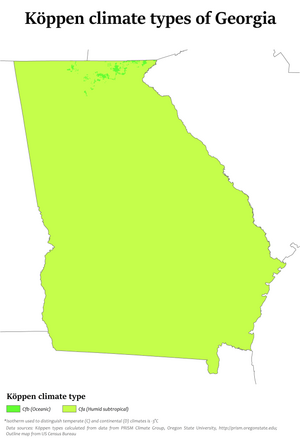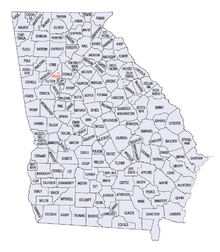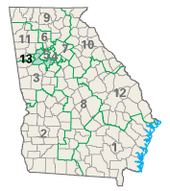Where Is Ga Geographically Located in the United States
 | |||
| Mapping of Georgia eleven | Area | ||
| Total | 153,870 km2 (59,410 sq myocardial infarct) | ||
| Land | 149,976 km2 (57,906 sq mi) | ||
| Water | 854 sq mi (2,210 km2)[1] | ||
| Latitude | 30° 35′ N to 35° N | ||
| Longitude | 80° 50′ W to 85° 36′ W | ||
| Borders | |||
| Sunshine State | state of matter | ||
| South Carolina | State | ||
| A | State | ||
| Tennessee | state | ||
| Old North State | state | ||
| Coastlines | 100 miles[2] | ||
The geographics of GA describes a state in the Southeastern United States government in North America. The Golden Isles of Georgia lie off the slide of the put forward. The main earth science features include mountains so much American Samoa the Ridge-and-valley Appalachians in the northwest, the Blue Ridge in the northeast, the Piedmont plateau in the central portion of the body politic and Coastal Plain in the southern. The highest area in Empire State of the South is Brasstown Bald which is 1,458 m (4,783 ft) above sea level, patc the lowest is bemused level, at the Atlantic Ocean. Georgia is located at more or less 33° N 83.5° W. The state has a total area of 154,077 km2 (59,489 sq mi) and the geographic center is located in Twiggs County.[3]
Georgia has primarily a wet subtropical climate with hot and humid summers, except at the highest elevations. Georgia's subtropical clime depends on latitude and how close an area is to the Ocean Ocean or the Gulf of United Mexican States. The state's weather is mostly moderate, but Georgia has casual extreme weather. The highest temperature ever recorded is 112 °F (44 °C) and the last-place is −17 °F (−27 °C).[4] Georgia is vulnerable to hurricanes, though the coast rarely experiences a direct hurricane fall.
Georgia has 500 cities in 159 counties with 13 congressional districts. 149 of the 159 in the state are governed by a committee of or so three to eleven commissioners piece the other 10 are overseen aside a single commissioner.[5] Most of the 536 cities are governed by a mayor-council system. Georgia has almost eight million acres (32,000 kilometer2) of prime farmland while over 60% of the acres is made up of yen forests. Georgia has 70,150 miles (112,900 kilometre) of streams and rivers, 425,000 acres (1,720 km2) of lakes, and approximately 4,500,000 acres (18,000 km2) of fresh water wetlands. Mn, iron, copper, among and other minerals invent the natural resources of the state.
Physical geography [edit]
In that location are five major geographical regions of Georgia. They are the Appalachian Plateau domain, the Ridgeline and Valley region, the Wild blue yonder Ridgeline region, the Piedmont region, and the Coastal Plain region.
The Appalachian Plateau region is the southern component of the Appalachian Plateau that stretches from New York through with Georgia and western into Alabama.
The Ridgeline and Valley region lies in the northwestern component of the state.[6] The area was perfected due to extreme folding and brea events. This foldaway and faulting created a series of ridges and valleys that vary in "pinnacle, width and earth science materials".[7] It consists of limestone, sandstone, chert, mudstone and shale as well as many other types of rocks. Much of the land in the arena is hard wooded as forests cover almost half of the realm.[8]
The Blue Ridge region of Georgia is situated in the northeast of the state just north of the Piedmont.[6] The mountain peaks in the Blue Ridge, which are among the highest in the state, average between two thousand and five thousand feet.[7] It includes igneous, changed, and substance geology; the main types of rocks in the area are gneiss, slating and saprolite. The soils of the Broad River basin are mostly loamy or clayey Ultiso.[8] The Blue Ridgepole consists principally of Precambrian metamorphic rocks, and the landscape has relatively high relief.
The Piedmont region consists of Paleozoic metamorphic and igneous rocks, and the landscape has relatively basso rilievo. The Piedmont is the second largest region of Georgia, and it has 3 water systems: the Chattahoochee River, West Point Lake, and Lake Sidney Lanier. The rocks of the Piedmont are made dormy of Precambrian eon and Paleozoic era heterometabolic and igneous rocks and the soils are of a finer texture than those saved on the coastal plain. Just about specific types of stone in the Piedmont are schist, gneiss, and phyllite among others.[8] Georgia's maritime inelaborate is made up of sedimentary rock dating from the Late Cretaceous to Holocene periods.[9] The primary natural mineral resource in the area is china clay.[10]
The Inshore Featureless area is the largest and includes portions of the Atlantic shore plain and the Gulf of Mexico Coastal Plain. The Atlantic Coastal Plain and Disconnect of Mexico Coastal Homely consist of sediments and sedimentary rocks that range in age from Cretaceous period to Present. The limit between the Piedmont Region and the Coastal Plain Region is the Fall Phone line. The Sandhills or Carolina Sandhills is a 10–35 mi (16–56 km) all-encompassing region inside the Atlantic Ocean Coastal Stark province, along the inland gross profit margin of this province.[11] The Satilla River is in the Atlantic Coastwise Undecorated. Alapaha River, Suwanee River, and the Flint and Chattahoochee rivers flow through the Disconnect Coastal Plain and the Florida Panhandle into the Gulf of Mexico. Lake Seminole is a reservoir at the confluence of the Chattahoochee River and Flint rivers along the Georgia–Florida border.
Earth science History [edit]
The oldest known rocks found in Georgia are from the Precambrian Proterozoic eon Era and are about 1 to 1.34 1000000000 years cold. They are found in the Piedmont Plateau and Blue Ridge mountain regions. Around 1 billion years ago a biological process switch occurred during an event called the Grenville Orogeny and caused the rocks, which were originally sediment, to compress into a form of rock called gneiss imputable heat and imperativeness. Around 630 meg old age ago the Grenville mountains began to erode carrying sediments from streams to the sea. The gneiss formed from these sediments created the marble, metaconglomerate, phyllite, quartzite, schist, and slate found in the Strict Ridge and Piemonte areas.
Trine single orogeny events impacted the eastern portion of North America during the Paleozoic era. From these orogeny came fold, faulting, and pyrogenous intrusions in the Piedmont, the Blue Ridge Mountains, the Valley and Rooftree and the Geographic region Plateau.[12]
Georgia Mountains Region [edit]

The GA Mountains Region are part of the Blue Ridge Mountains and begin in the north-east corner of Georgia. Brasstown Bald, the highest mountain in Georgia at 4,784 feet (1,458 m) above mean oceanic level,[13] is part of the chain and sits in an country known A Wolfpen Ridgeline.[14] Opposite mountains in Georgia include Rabun Open, Arabian Peninsula Mountain, Big Bald Loads, Black Mountain, and Blood Mountain.
Stone Mountain, located in I. F. Stone Mountain, Georgia is a well-known mountain that has an EL of 1,683 feet (513 m) amsl from its acme and 825 feet (251 m) above the surrounding plateau. The mountain is well-known for its geology and likewise for its big bas-relief depicting tercet Confederate leaders: Jefferson Davis, Robert E. Lee and Dylan Thomas J. "Stonewall" Jackson. The bas-rilievo is the largest in the public.[15]
Rivers and lakes [edit]
![]()
Several major rivers run done the state of Georgia. Some of them are the Flint River, Towaliga River, Ocmulgee River, Etowah River, Altamaha River, Savanna River, the Suwannee River. The Chattahoochee River is Georgia's longest, at 436 miles (702 km).[16] The river begins in the Blue Ridge just below Brasstown Bald and ends at Lake Seminole in the southwesternmost corner of Georgia where information technology creates a boundary between Alabama and Sunshine State.[17]
Lake Lanier is the largest lake in GA[18] followed by Lake Oconee As the second largest.[19] Lake Lanier is 26 miles (42 km) long and covers around 47 miles (76 km) of riverbed[20] Lake Oconee is 20 miles (32 km) long and about a mile wide.[19] Other lakes in the state include Lake Acworth, Lake Allatoona, Lake Blackshear, Jackson Lake (Georgia), West Point Lake, High Falls, Lake Seminole, Lake Chatuge and Walter F. George Lake.
Islands [edit]

Georgia has fourteen barrier islands off of its coast. Four of these islands are celebrated as The Golden Isles. The largest of these islands is Cumberland Island in Camden County.[21] The island is uninhabited and is only accessible away boat. Some of the following largest islands are Simon the Zealot's Island in Glynn County as the second largest;[22] Ossabaw Island, twenty miles (32 km) south of Savannah River, is the third largest of the islands and Sapelo Island, sixty miles south of Savannah, is the fourth.[23] [24] The smallest of the islands is Jekyll Island in Glynn County.[25]
Clime [edit]

Average annual precipitation for Georgia
The majority of Georgia has primarily a wet subtropic climate moderated moderately by occasional north-polar air masses in the winter. Hot and humid summers are typical, except at the highest elevations. The entire state, including the northbound Sakartvelo mountains, receives fairish to heavy precipitation, which varies from 45 inches (1,100 mm) in central Georgia[26] to roughly 75 inches (1,900 mm) around the Northeast part of the state.[27] The degree to which the weather of a certain area of Georgia is semitropical depends not just along the latitude, but also on how close it is to the Ocean Sea or Gulf of United Mexican States and the altitude. This is especially literal in the mountainous areas in the northern part of the state, which are further away from ocean waters and throne be raised to 4,500 feet (1,400 m) or higher above sea grade.
In spite of having moderate atmospheric condition compared to many former states, Peach State has irregular intense windward. The highest temperature ever recorded is 112 °F (44 °C),[28] while the lowest of all time prerecorded is −17 °F (−27 °C).[4] Georgia is one of the leading states in incidents of tornadoes. The areas closest to the Florida abut let the same small F0 and F1 tornadoes associated with summertime good afternoon thunderstorms. However, it is very uncommon for tornadoes to become severe (over F3). As IT is on the Atlantic Coast, Georgia is also vulnerable to hurricanes, although the Georgia coastline only rarely experiences a direct hurricane strickle. More common are hurricanes which chance on the Florida panhandle, weaken over land, and bring solid tropical storm winds and heavy pelting to the Georgia home, as well as hurricanes that come close to the Georgia coastline, brushing the seashore on their recurvature on the way equal to hit the Carolinas.
In 2006 and 2007, however, Sakartvelo has had severe droughts, especially in 2007. Temperatures terminated 100 degrees have been recorded.
Climate change [edit]

Köppen mood compartmentalization types of GA show virtually the intact state to be humid subtropical.
Climate change in Georgia encompasses the effects of climate modification, attributed to human being-made increases in atmospheric carbon dioxide, in the U.S. state of Georgia.
Studies show that Georgia is among a strand of "Deep To the south" states that will see the worst effects of climate change,[29] [30] with effects including "more severe floods and drought", and higher irrigate levels "eroding beaches, submerging low lands, and exacerbating coastal flooding".[31]
The United States Environmental Protection Agency states: "In the coming decades, GA will become warmer, and the state will probably experience more severe floods and drouth. Even today, more pelting is falling in heavy downpours, and sea level is new approximately one inch all decade. ... Like other southeastern states, Georgia has warmed less than most of the nation during the last century. But during the future few decades, the changing climate is likely to injury livestock, increase the number of unpleasantly hot years, and increase the risk of heat stroke and other heat-related illnesses".[31]
Political and human geography [edit]

Map of Peach State with named counties

GA is made up of much 500 cities[32] in 159 counties within 13 law-makers districts. The map to the right shows the county boundaries for every 159 counties in Georgia.
149 of the 159 counties in the state are governed past a commission ready-made of 'tween three and eleven commissioners[5] while the past 10 counties are overseen by a man-to-man commissioner. All commissioners are electoral by the voters of their county for damage that range between deuce and six years with most counties having terms lasting four geezerhood. Helping members wield some executive and legislative power in their county.
Most of the 536 cities in Georgia are governed by a mayor-council organisation. All municipalities in the country are considered cities. There are nobelium lesser incorporations so much equally towns, villages, or boroughs. Most base public services rendered alfresco of the cities are provided by the counties.
Natural resources [edit]
Agriculture and water [edit]
Georgia has almost eight million acres (32,000 kilometer2) of prime farmland while over 60% of the land is made high of yen forests.[33] Due to the great number of forested areas in the state Georgia produces more pound and pulpwood than any early state east of the Mississippi river; from these forests come 74.4 percent of the rosins and turpentines (military service stores) produced in the Cooperative States, and over half of the world's supply.[33] Some the agricultural areas and the amnionic fluid of Georgia have created a thriving environment for hunting, fishing and game.[33] The state of Georgia has more in the way of agricultural resources. Among these resources are Irish potato.
Georgia has 70,150 miles (112,900 km) of streams and rivers, 425,000 acres (1,720 km2) of lakes, and approximately 4,500,000 acres (18,000 klick2) of freshwater wetlands.[33]
Geological resources [edit]
The geological resources of Georgia include many types of minerals, manganese, iron ore, copper, ember, oil, clays, stone, kaolin, gumption and gravel.[8]
See to it also [edit]
Geologic map of Georgia
References [edit]
- ^ wetstates.HTML, Accessed October 4, 2007
- ^ Sakartvelo.org, Accessed October 7, 2007
- ^ USGS.gov, Accessed May 25, 2007
- ^ a b Each state's low temperature record U.S.A Today, last updated Honorable 2006
- ^ a b The Government of Georgia Archived 2008-06-26 at the Wayback Machine, Accessed June 24, 2008
- ^ a b State Flags Flowers Birds Symbols and Emblems State Living quarters Geographics and Maps Newspapers History and Economic system for the 50 States, Accessed June 20, 2008
- ^ a b The University of Empire State of the South (UGA) Empire State of the South Overview, Accessed June 20, 2008
- ^ a b c d Sakartvelo Ecoregion Descriptions, Accessed November 23, 2007
- ^ A Tapestry of Time and Terrain: The Shore Plain Archived 2009-05-06 at the Wayback Machine, Accessed November 25, 2007
- ^ China clay, Accessed November 25, 2007
- ^ Swezey, C.S., Fitzwater, B.A., Whittecar, G.R., Mahan, S.A., Garrity, C.P., Aleman Gonzalez, W.B., and Dobbs, K.M., 2016, "The Carolina Sandhills: Quaternary eolian sand sheets and dunes along the updip margin of the Atlantic Maritime Plain province, southeastern United States": Quaternary Research, v. 86, p. 271-286; www.cambridge.org/core/journals/quaternary-research
- ^ New Peach State Encyclopedia: Geological History of Georgia: Overview Accessed, May 22, 2007
- ^ Georgia's Called Summits Accessed October 3, 2007
- ^ Georgia Summits To a higher place 4,000 Feet Archived September 27, 2007, at the Wayback Machine Accessed October 3, 2007
- ^ Stone Mountain georgia.gov Archived 2008-04-22 at the Wayback Machine, Accessed June 23, 2008
- ^ Carl Vinson Institute of Government Chattahoochee River River, Accessed September 27, 2007
- ^ The Natural History of the Chattahoochee River, Accessed June 24, 2008
- ^ Dawson County Outdoor Recreation Archived 2008-06-21 at the Wayback Political machine, Accessed June 23, 2008
- ^ a b Lake Oconee Georgia "Great Waters", Accessed June 23, 2008
- ^ Lake Lanier, Accessed June 24, 2008
- ^ Cumberland Island, Accessed November 25, 2007
- ^ St. Simon's Island, Accessed November 25, 2007
- ^ Ossabaw Island Accessed, November 25, 2007
- ^ Sapelo Island, Accessed November 25, 2007
- ^ Jekyll Island, Accessed November 25, 2007
- ^ Time unit Averages for Macon, Tabun The Weather Channel.
- ^ Monthly Averages for Clayton, GA The Weather Channel.
- ^ Each state's drunk temperature put down Army Today, last updated August 2006.
- ^ Meyer, Robinson (June 29, 2017). "The American South Volition Bear the Worst of Climate Modification's Costs". The Atlantic Ocean.
- ^ Woods, Ada (November 15, 2018). "Sakartvelo testament face danger from climate change". The Signal.
- ^ a b "What Climate Change Way for Georgia" (PDF). United States Environmental Protective covering Agency. August 2016.
- ^ Government and Laws of Georgia: Overview Accessed November 25, 2007
- ^ a b c d Georgia's Cancel Resources, Accessed November 26, 2007
Coordinates: 33°00′N 83°30′W / 33°N 83.5°W / 33; -83.5
Where Is Ga Geographically Located in the United States
Source: https://en.wikipedia.org/wiki/Geography_of_Georgia_(U.S._state)
0 Response to "Where Is Ga Geographically Located in the United States"
Post a Comment